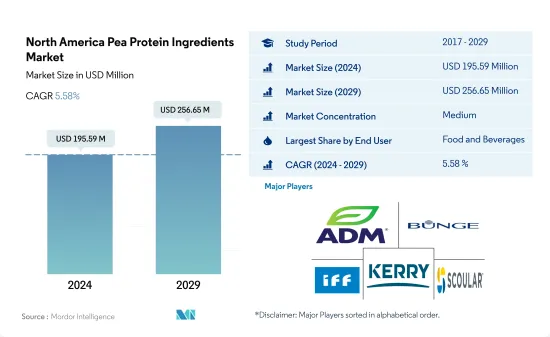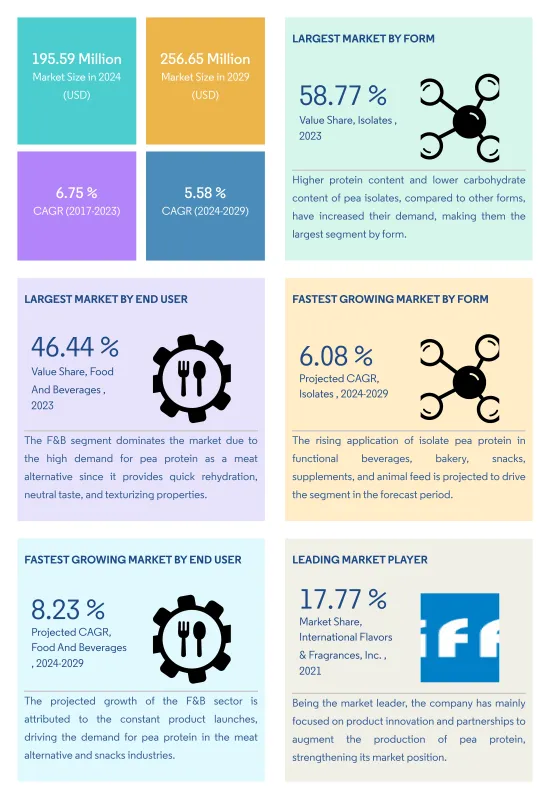Need help finding what you are looking for?
Contact Us
PUBLISHER: Mordor Intelligence | PRODUCT CODE: 1430642

PUBLISHER: Mordor Intelligence | PRODUCT CODE: 1430642
North America Pea Protein Ingredients - Market Share Analysis, Industry Trends & Statistics, Growth Forecasts (2024 - 2029)
PUBLISHED:
PAGES: 223 Pages
DELIVERY TIME: 2-3 business days
SELECT AN OPTION
The North America Pea Protein Ingredients Market size is estimated at USD 195.59 million in 2024, and is expected to reach USD 256.65 million by 2029, growing at a CAGR of 5.58% during the forecast period (2024-2029).


F&B sector accounted major share in 2022 with an growing demand for meat alternatives products.
- The food and beverage segment is the region's leading application segment for pea proteins, led by meat alternatives and RTE/RTC food products. In 2022, these two sub-segments held a volume share of 57% in the overall pea protein consumed in North America. Another important segment for pea protein is the supplements segment, which registered a CAGR of 4.47% during the study period. This progress indicates a trend of supplements becoming a common part of daily life and being considered more wholesome, satisfying, and nutritious.
- The increasing preference for plant protein-based foods and beverages is leading companies to invest strategically in the industry. North America is becoming one of the prime established markets for plant-based meat globally, with the meat and meat alternatives segment expected to grow the fastest with respect to pea protein. The segment is projected to register a CAGR of 10.48% during the forecast period.
- In the region, veganism is becoming more popular. More people are switching to vegan diets and only buying plant-based products. The increasing acceptance of vegan diets is anticipated to be advantageous for manufacturers of plant-based protein supplements. In 2021, 0.5% of the US population (1.62 million) was estimated to be vegan. While a small number of Americans are vegan, in reality, the number of people who are not completely vegan but aspire to be is far higher. 39% of Americans state that their diets do not consist entirely of plant-based foods, but they want to become fully vegan by avoiding as many animal-related foods as possible.

- The United States retained its top position in the region in 2022. Pea protein has gained significant traction in the country due to widespread consumer acceptance of versatility across different applications. Manufacturers also prefer pea protein, quoting its ability to meet nutritional, functional, and label objectives. The country was followed by Mexico and Canada in terms of market value, driven by the food and beverage sector.
- Companies are ramping up their production to address the growing demand for pea protein in the United States. In 2021, Cargill's Puris launched its new US facility with a forecast to double the production of its pea protein ingredient. Similarly, Ingredion has expanded its "on-trend" line of plant-based solutions for the F&B industry, adding two pea-based ingredients to its Nebraska-based pea protein factory. Such constant competitive developments in the region are anticipated to further drive the growth of the F&B sector, registering a CAGR of 5.49%, by volume, during the forecast period.
- Mexico is the fastest-growing country in the global pea protein market. It is projected to register a CAGR of 8.05% in terms of value during the forecast period. There is an increasing concern for mitigating the threat of serious diseases such as cardiovascular diseases and obesity associated with the excess consumption of meat, which is the major component of Mexican food. About 73% of the Mexican population is overweight. This is causing people to shift to healthier alternatives, such as pea-based protein products, thereby resulting in market growth.
North America Pea Protein Ingredients Market Trends
Plant protein consumption growth fuels opportunities for key players in the ingredients sector
- The per capita consumption of plant protein increased from 135.3 grams in 2016 to 147.67 grams in 2021 within the North American region, supported by both investment and innovation. This increase was mainly due to the rise in the rate of consumers turning vegan or vegetarian in a bid to ensure animal welfare. For instance, the number of Americans following plant-based diets has increased by roughly 9.6 million people, accounting for nearly 3% of the population in the United States. After the COVID-19 pandemic, plant protein consumption skyrocketed for various reasons, including the fear of processing contamination by the virus in animal-sourced proteins and the hike in consumption of protein combinations, including animal and plant proteins or a combination of distinct plant proteins.
- Dalhousie University Agri-Food Analytics Lab states that flexitarian is the second-largest dietary group in Canada. The percentage of consumers becoming flexitarian or vegan offers manufacturers enough opportunities to introduce and innovate more in the plant protein segment. In 2021, the Canadian government announced an investment of more than USD 4.3 million to support Canada's pulse and special crop farmers to meet the growing consumer demand for sustainable, high-quality plant-based protein.
- The rising vegan population mainly drives the market. The per capita consumption of pea protein is the highest, owing to its wide application in distinct food products like meat, poultry, and bakery. Pea protein consumption is mainly observed through sports nutrition and meal replacement applications, at levels ranging from 5 to 15 grams per serving at one or two servings per day, with a maximum of 30 grams per person per day.

United States and Canada are one of the major pea producer across North America
- Pea production in North America is primarily dominated by Canada in the region and globally. This is followed by the United States, which is the second-largest producer of peas in the region. In Canada, states like Saskatchewan, Alberta, and Manitoba are the leading producers of peas. Pea production in North America increased by 32% from 2015 to 2020. In 2020, the region was primarily inclined toward dried pea production, which accounted for a 95% share, followed by green peas, which accounted for a 5% share in the overall production of pea protein commodities.
- Dry pea production is projected to increase over the coming years due to a constant increase in yields. For instance, lower harvested area, particularly in Alberta, was observed to produce higher yields in 2020. The Government of Canada projected that Alberta and Saskatchewan would produce 4.1 MT of dry peas, with the remainder of the production expected in Manitoba, British Columbia, and Eastern Canada. On the other hand, in the United States, the unstable production of dry peas was due to a fall in the area seeded in North Dakota, together with lower yields and higher abandonment. During 2020-2021, the USDA forecasted that the US dry pea production would decrease by 17% to just over 0.8 MT.
- The higher pea production in Canada has made manufacturers consider Canada an apt location for establishing new pea protein processing plants. This may enable them to gain marginal profits by saving distinct supply chain costs like transportation and storage. For instance, in November 2021, Roquette, a North American pea protein producer, opened the world's largest pea protein plant in Portage la Prairie, Canada. The new plant processes yellow peas into powdered fibers, protein, and starch for applications in the pharma sector.

North America Pea Protein Ingredients Industry Overview
The North America Pea Protein Ingredients Market is moderately consolidated, with the top five companies occupying 55.72%. The major players in this market are Archer Daniels Midland Company, Bunge Limited, International Flavors & Fragrances, Inc., Kerry Group PLC and The Scoular Company (sorted alphabetically).
Additional Benefits:
- The market estimate (ME) sheet in Excel format
- 3 months of analyst support
Product Code: 90089
TABLE OF CONTENTS
1 EXECUTIVE SUMMARY & KEY FINDINGS
2 INTRODUCTION
- 2.1 Study Assumptions & Market Definition
- 2.2 Scope of the Study
- 2.3 Research Methodology
3 KEY INDUSTRY TRENDS
- 3.1 End User Market Volume
- 3.1.1 Baby Food and Infant Formula
- 3.1.2 Bakery
- 3.1.3 Beverages
- 3.1.4 Breakfast Cereals
- 3.1.5 Condiments/Sauces
- 3.1.6 Confectionery
- 3.1.7 Dairy and Dairy Alternative Products
- 3.1.8 Elderly Nutrition and Medical Nutrition
- 3.1.9 Meat/Poultry/Seafood and Meat Alternative Products
- 3.1.10 RTE/RTC Food Products
- 3.1.11 Snacks
- 3.1.12 Sport/Performance Nutrition
- 3.1.13 Animal Feed
- 3.1.14 Personal Care and Cosmetics
- 3.2 Protein Consumption Trends
- 3.2.1 Plant
- 3.3 Production Trends
- 3.3.1 Plant
- 3.4 Regulatory Framework
- 3.4.1 United States
- 3.5 Value Chain & Distribution Channel Analysis
4 MARKET SEGMENTATION (includes market size in Value in USD and Volume, Forecasts up to 2029 and analysis of growth prospects)
- 4.1 Form
- 4.1.1 Concentrates
- 4.1.2 Isolates
- 4.1.3 Textured/Hydrolyzed
- 4.2 End User
- 4.2.1 Animal Feed
- 4.2.2 Food and Beverages
- 4.2.2.1 By Sub End User
- 4.2.2.1.1 Bakery
- 4.2.2.1.2 Beverages
- 4.2.2.1.3 Breakfast Cereals
- 4.2.2.1.4 Condiments/Sauces
- 4.2.2.1.5 Confectionery
- 4.2.2.1.6 Dairy and Dairy Alternative Products
- 4.2.2.1.7 Meat/Poultry/Seafood and Meat Alternative Products
- 4.2.2.1.8 RTE/RTC Food Products
- 4.2.2.1.9 Snacks
- 4.2.3 Personal Care and Cosmetics
- 4.2.4 Supplements
- 4.2.4.1 By Sub End User
- 4.2.4.1.1 Baby Food and Infant Formula
- 4.2.4.1.2 Elderly Nutrition and Medical Nutrition
- 4.2.4.1.3 Sport/Performance Nutrition
- 4.3 Country
- 4.3.1 Canada
- 4.3.2 Mexico
- 4.3.3 United States
- 4.3.4 Rest of North America
5 COMPETITIVE LANDSCAPE
- 5.1 Key Strategic Moves
- 5.2 Market Share Analysis
- 5.3 Company Landscape
- 5.4 Company Profiles (includes Global Level Overview, Market Level Overview, Core Business Segments, Financials, Headcount, Key Information, Market Rank, Market Share, Products and Services, and Analysis of Recent Developments).
- 5.4.1 Archer Daniels Midland Company
- 5.4.2 Bunge Limited
- 5.4.3 Cargill Incorporated
- 5.4.4 Farbest-Tallman Foods Corporation
- 5.4.5 Glanbia PLC
- 5.4.6 Ingredion Incorporated
- 5.4.7 International Flavors & Fragrances, Inc.
- 5.4.8 Kerry Group PLC
- 5.4.9 Roquette Freres
- 5.4.10 The Scoular Company
6 KEY STRATEGIC QUESTIONS FOR PROTEIN INGREDIENTS INDUSTRY CEOS
7 APPENDIX
- 7.1 Global Overview
- 7.1.1 Overview
- 7.1.2 Porter's Five Forces Framework
- 7.1.3 Global Value Chain Analysis
- 7.1.4 Market Dynamics (DROs)
- 7.2 Sources & References
- 7.3 List of Tables & Figures
- 7.4 Primary Insights
- 7.5 Data Pack
- 7.6 Glossary of Terms
Have a question?


SELECT AN OPTION
Have a question?


Questions? Please give us a call or visit the contact form.
